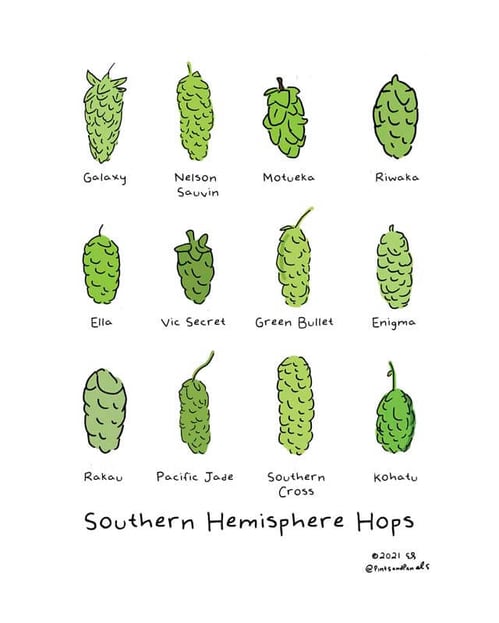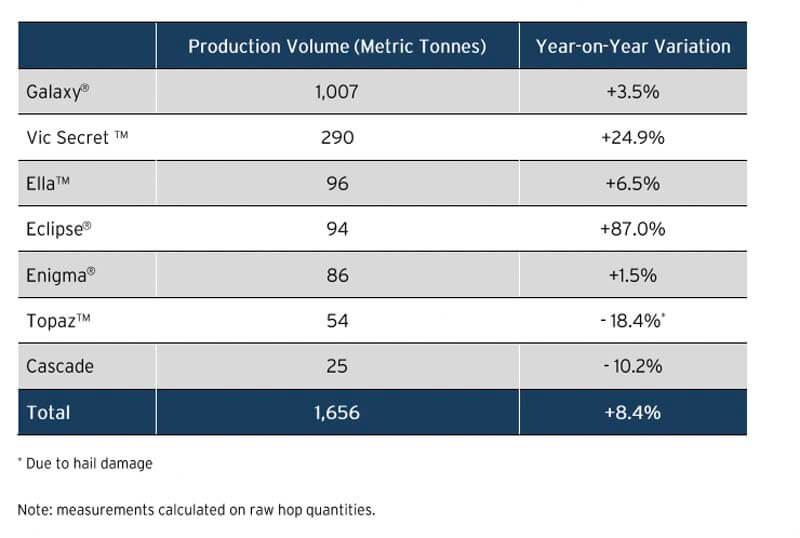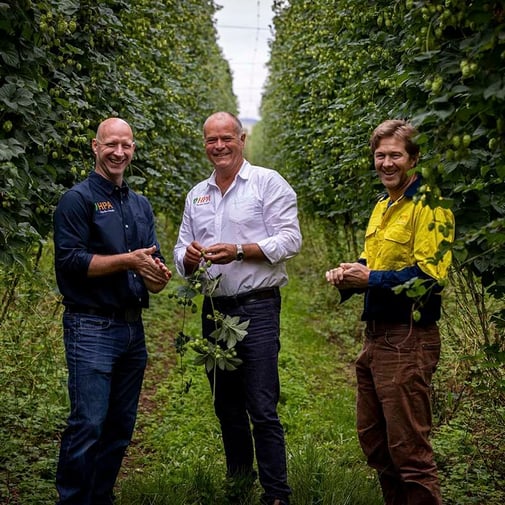The Complete Guide to All Southern Hemisphere Hop Varieties

September 1, 2022

Last week, we took a look at all of the hops currently grown in America, identifying the most popular along with common characteristics for each.
But hops are cultivated all over the world. And more recently, Southern Hemisphere hops have garnered a lot of attention.
Brewers love the more white wine-like flavors of Southern Hemisphere hops, ranging from citrusy to tropical.
They’re a perfect palette for beers such as pale ales, IPAs, and hazies. All of which dominate the limelight in the current craft beer industry.
Accordingly, new styles have even emerged to identify hops from these regions, including Australian Pale Ale, Australian-style IPA, New Zealand Pale Ale, and New Zealand-style IPA. In fact, in 2021, the Brewers Association added New Zealand-style Pale Ale and New Zealand-style IPA to its list of official styles for the first time.
Plus, just take a look at a very small smattering of breweries across the U.S. that have been known to use Southern Hemisphere hops: Other Half, Firestone Walker, Tree House, Trillium, Toppling Goliath, Ex Novo, and many, many more.
All signs point to Southern Hemisphere hops currently enjoying their moment in the spotlight.
So we are diving into why these hops have become so popular, some of the top varieties, and the specs behind all Southern Hemisphere hops.
Editor's Note: This is part two of a three-part series covering hops across the world. For this piece, we’ll cover hops native to the Southern Hemisphere, but take a look at our Complete Guides to All American Hop Varieties and Noble Hops.
What We’ll Cover in This Piece:
Why Are Southern Hemisphere Hops Important?
Grown in regions south of the equator such as Australia, New Zealand, and even South Africa, Southern Hemisphere hops feature a completely different flavor profile than those grown in America or Europe.
Characterized as more juicy, tropical, and fruity, Southern Hemisphere hops have played a huge role in helping brewers create beers that appease consumers’ demand for juicier IPAs and beers.
In fact, the entire focus of Southern Hemisphere hops tends to be on flavor over aroma or bittering, with many Southern Hemisphere hops categorized as dual purpose.
Such as Nelson Sauvin and Australian Galaxy, which tend to be higher in alpha acids, allowing brewers to focus more on flavor impact from these hops.
According to The State of Hops report from First Key Consulting, “one of the first flavour hops was the New Zealand-bred Nelson Sauvin, named for the city around which it is cultivated and the Sauvignon Blanc-like aromas and flavours it produces, alongside other strongly fruity Kiwi hops like Riwaka, and later on, the Australian Galaxy.”
The report continues, “these hops allowed brewers to craft bold flavours and aromas with or without their associated bitterness.”
Southern Hemisphere hops open up an entirely new palette for brewers to play with. Accordingly, hops from Australia, New Zealand, and South Africa have made their way into more and more beers.
Last April, Hop Products Australia (HPA) reported in its 2022 Crop Report that it collected 1,656 metric tons of hops during its harvest, an 8.8% net increase year-on-year. Overall, Hop Products Australia noted that 2022 marked twelve years of continuous growth.
And in New Zealand, an $8.5 million investment in 2018 has helped take New Zealand's hop breeding and growing to new heights. In 2020, NZ Hops Ltd. reported a record-breaking harvest, collecting 1,231,936 kilograms (2.7 million pounds) of hops, an 18% increase from the previous year.
“While flavour hops are now widely cultivated, their spiritual home seems to be where they are still the best, the southern hemisphere in general and Australasia in particular,” writes the State of Hops report. “While southern hemispheric hops are still but a tiny piece of the global hops trade, their influence is outsized and it would be reasonable to expect that it will grow even more so in the coming years as new hop varieties come online.”
What Are the Hottest Southern Hemisphere Hops of 2022?

Without a doubt, there are certain hop varieties grown in Australia, New Zealand, and South Africa that have excelled.
Actually, according to the First Key Consulting’s State of Hops report, the hops industry has doubled in Australia over the past five years with year-to-year increases in hop acreage and a demand for varieties like Nelson Sauvin, Riwaka, and Australian Galaxy remaining high.
In Australia specifically, HPA recently completed a significant $35 million capital expansion project to plant 300 new hectares of what they called “in-demand” Aussie flavor hops including Eclipse®, Galaxy®, and Vic Secret™.
According to HPA’s 2022 Crop Report, the following five hop varieties led the way in production volume by metric tonnes: Galaxy® (1,007), Vic Secret™ (290), Ella™ (96), Eclipse® (94), and Enigma® (86).

In New Zealand, American brewers have gone ga-ga for Nectaron, ranking the NZ Hops Ltd. co-op’s hop fifth in an inquiry of hops they want more of, according to a 2021 Brewers Association member survey.
Even more impressive, Nectaron is still an extremely nascent hop, coming to market last year after a seventeen-year collaboration with New Zealand’s Plant & Food Research.
Brewers have praised Nectraon for its intense pineapple, passion fruit, peach, and grapefruit qualities, making the hop perfect for those aforementioned hazies, IPAs, and pale ales.
Other top varieties according to Beer Maverick, a website built for and by avid homebrewers and craft drinkers, include Nelson Sauvin, Motueka, and Wai-iti.
And the innovation coming out of New Zealand shows no sign of slowing down. This year, NZ Hops Ltd. announced a new program called the Bract Brewing Programme, which takes trial hops grown by Master Growers in the Tasman region of New Zealand and sends them to sixty different breweries around the world. The experimental hops known as NZH-101, NZH-102, NZH-104, and NZH-105 will be exclusively delivered to these breweries for them to use in single-hopped beers as a trial by fire. Hopefully, some or all of these hops will eventually join NZ Hops’ current list of seventeen varieties
These aforementioned hops are just a smattering of the ones available from the Southern Hemisphere. While the numbers don’t quite reach the sheer volume of hops in the United States, Southern Hemisphere hops have cultivated enough attention and favor to put them onto any brewer’s radar.
For that reason, we’ve put together a handy cheat sheet covering the specs behind all the different varieties.
A Complete Guide to All Southern Hemisphere Hop Varieties
After looking at the most-trending hops in the Southern Hemisphere, we’ve compiled a list of Southern Hemisphere hops along with some essential information to know about each including: description, type, alpha acid range, aroma notes, best beer styles, and possible substitutions.
Editor’s Note: Consider this a cheat sheet. We’re not brewers, so we can’t proclaim this is the most exhaustive guide. For that reason, we’ve sourced all of the information below from a few very reputable hop vendors, merchants, and growers.* All descriptions, alpha acid ranges, aroma notes, beer styles, and substitution suggestions come courtesy of NZ Hops Ltd., Hop Products Australia, ZA Hops, Yakima Valley Hops, Yakima Chief Hops (YCH), Hoplist, John I. Haas, and Beer Maverick.
* To get the best and most up-to-date information on any hop variety, be sure to ask your own vendors, hop merchants, or hop growers.

Australian Hop Varieties
Below you'll find a list of the most-trending Australian hops. Simply click on the hop name to learn more about it.
Eclipse®
Country of Origin: Australia
Description: Hop Products Australia’s newest proprietary hop imparts fruit-forward flavors of sweet mandarin, citrus peel, and fresh pine needles. (HPA)
Type: Dual purpose
Alpha Acid Range: 15.7-18.7%
Aroma/Flavor Notes: Sweet mandarin, zesty citrus peel, fresh pine needles
Best Beer Styles: IPA, NEIPA
Substitutions: NA
Ella™
Country of Origin: Australia
Description: Previously named Stella, Ella™ is the little sister of the Australian superstar Galaxy®. Ella™ and Galaxy® share the same mother, but Ella's father is a variety from Spalt, Germany. This parentage gives Ella™ a pleasant floral aroma that is backed by soft spice. These qualities work best in lagers and pilsners, but Ella™ can be incorporated into Pale Ales and IPA during dry hopping. This will preserve some of the lighter oils that are more fruity and tropical like in Galaxy®. (Yakima Valley Hops)
Type: Dual purpose
Alpha Acid Range: 13.4-19.2%
Aroma/Flavor Notes: Floral, spice, grapefruit, tropical
Best Beer Styles: Lager, pilsner, pale ale, stout
Substitutions: Perle, Palisade
Enigma®
Country of Origin: Australia
Description: Enigma® is a new, exciting hop bred and released by the Hop Products Australia program of the Barth-Haas Group. It is a cross between Tettnanger and an unnamed North American variety but displays in a wholly unique manner. It is juicy with red fruits like raspberries and red currants, but what sets it apart from other varieties are the white wine notes (similar to Nelson Sauvin), that is most often described as crisp and refreshing "Pinot Gris." (Yakima Valley Hops)
Type: Dual purpose
Alpha Acid Range: 16.7-19.4%
Aroma/Flavor Notes: White grape, raspberry, red currant, rockmelon
Best Beer Styles: IPA, pale ale
Substitutions: Nelson Sauvin, Hallertau Blanc
Galaxy®
Country of Origin: Australia
Description: Galaxy® hops are currently one of the most sought-after hop varieties in the world. Galaxy® hops are prized for their big aromas of peach, guava, and oranges. Galaxy® hops are perfect in hazy IPAs and work well with the usual suspects of Citra® and Mosaic®. (Yakima Valley Hops)
Type: Dual purpose
Alpha Acid Range: 13-18.5%
Aroma/Flavor Notes: Passion fruit, peach, citrus
Best Beer Styles: Pale ale, IPA, ESB
Substitutions: Citra®, Amarillo®, Centennial
Helga
Country of Origin: Australia
Description: Bred in 1986 and formerly known as Southern Hallertau, Helga™ is a descendant of Hallertau Mittelfrüh. Its brewing characteristics resemble that of its parent; however, it demonstrates a forgiving and refined character in a variety of beer styles and hop applications. (YCH)
Type: Dual purpose
Alpha Acid Range: 5.4-7.3%
Aroma/Flavor Notes: Noble characteristics, herbal, earthy
Best Beer Styles: Ales
Substitutions: Hallertau
Opal
Country of Origin: Australia
Description: Developed at the Hüll Research Center, Opal exhibits excellent aroma characteristics combined with a respectable alpha acid level. (YCH)
Type: Dual purpose
Alpha Acid Range: 13-14%
Aroma/Flavor Notes: Spice, pepper, citrus, with fruity, floral and herbal characteristics
Best Beer Styles: Pilsner, hefeweizen, helles, lager, brown ale, saison, tripel, wheat, kölsch, blonde ale
Substitutions: East Kent Golding, Styrian Golding
Pride of Ringwood
Country of Origin: Australia
Description: Pride of Ringwood imparts bitterness but also exhibits a hint of fruit and spice when used as a late addition. (HPA)
Type: Dual purpose
Alpha Acid Range: 9.5-10.5%
Aroma/Flavor Notes: Bittering resin with fruit and spice
Best Beer Styles: Amber ale, lager, fruit lambic, pale ale, Australian lager, strong ale, golden ale, American pale ale
Substitutions: East Kent Golding, Centennial, Galena, Cluster
Summer
Country of Origin: Australia
Description: Bred in 1997 at Tasmanian Bushy Park Breeding Garden, Summer is the result of open pollination of a tetraploid Czech Saaz. It features balanced citrus and stone fruit flavors but showcases distinct apricot and melon characteristics in dry hopping applications. (YCH)
Type: Aroma
Alpha Acid Range: 5.6-6.4%
Aroma/Flavor Notes: Apricot, melon
Best Beer Styles: NA
Substitutions: Palisade, Saaz (US)
Super Pride
Country of Origin: Australia
Description: Bred in 1987 at the Rostrevor Breeding Garden in Victoria and released in 1995, Super Pride is a daughter of Pride of Ringwood. It is predominantly used as a bittering hop but offers a subtle resin and fruit characteristic as well. (YCH)
Type: Dual purpose
Alpha Acid Range: 12.3-16.9%
Aroma/Flavor Notes: Mild and pleasant subtle resin and fruit tones
Best Beer Styles: Imperial pale ale, lager
Substitutions: Pride of Ringwood
Sylva™
Country of Origin: Australia
Description: Bred in 1997 at Tasmanian Bushy Park Breeding Garden, Sylva is a result of open pollination of Czech Saaz. Brewing characteristics closely resemble that of its parent, with complex yet subtle floral and herbal characteristics. (YCH)
Type: Aroma
Alpha Acid Range: 4.6-7%
Aroma/Flavor Notes: Floral, herbal, and noble characteristics
Best Beer Styles: Pilsner, lager, California common, pale ale
Substitutions: Hallertau Mittlefrüh, Helga, Saaz
Topaz™
Country of Origin: Australia
Description: Topaz™ imparts resinous, grassy flavours when added early, or lychee and light tropical fruit flavours when added late in larger doses. (HPA)
Type: Bittering
Alpha Acid Range: 16-20.1%
Aroma/Flavor Notes: Lychee, tropical fruit
Best Beer Styles: Amber ale, APA, IPA, session ale
Substitutions: Galaxy, Citra, Cascada, Riwaka, Rakau, Amarillo
Vic Secret™
Country of Origin: Australia
Description: Vic Secret™ imparts a clean pineapple flavour with subtle notes of pine and herbs, best accessed by dry hopping or whirlpool addition. Late kettle addition imparts pleasant earthy flavours without the fruit. (HPA)
Type: Dual purpose
Alpha Acid Range: 15.1-21.8%
Aroma/Flavor Notes: Pineapple, pine, herbs
Best Beer Styles: IPA, pale ale, porter, stout
Substitutions: Galaxy
New Zeland Hop Varieties
Looking for the top-trending hops from New Zealand? Use the list below.
Dr. Rudi
Country of Origin: New Zealand
Description: This triploid variety was first released in 1976 by the New Zealand Horticultural Research Center but was renamed in 2012 to honor the breeder who is largely considered the father of New Zealand's hop program. Dr. Rudi is the result of a Smoothcone mother and open pollination that displays bright aromas of pine, lime pith, and lemongrass. (Yakima Valley Hops)
Type: Dual purpose
Alpha Acid Range: 10-12%
Aroma/Flavor Notes: Citrus, woody aromatic, green-grassy, resin, pine, lemongrass
Best Beer Styles: Lager, IPA
Substitutions: Green Bullet
Green Bullet™
Country of Origin: New Zealand
Description: Released in 1972 from the New Zealand DSIR (now New Zealand Institute for Plant and Food Research), Green Bullet is a triploid alpha variety bred by open pollination of the New Zealand Smoothcone variety. It is traditionally considered a bittering variety for lagers, but also carries a spicy characteristic typical of Slovenian hop varieties. (YCH)
Type: Bittering
Alpha Acid Range: 12-14%
Aroma/Flavor Notes: Floral, resinous, spicy, dried fruit
Best Beer Styles: Bock, saison, IPA
Substitutions: Liberty, Hallertau, Crystal, Mount Hood, Ultra
Kohatu®
Country of Origin: New Zealand
Description: Developed by the New Zealand Institute for Plant and Food Research hop breeding program and released in 2011, Kohatu is a descendant of Hallertauer Mittlefruher. It works well in single-hop applications and is described as having intense fruit characteristics. (YCH)
Type: Dual purpose
Alpha Acid Range: 6-7%
Aroma/Flavor Notes: Berry, floral, passion fruit, tropical
Best Beer Styles: Ale, pale ale, IPA
Substitutions: Wai-iti, Motueka
Motueka™
Country of Origin: New Zealand
Description: Developed by the New Zealand Institute for Plant and Food Research hop breeding program and released in 1996, Motueka is a cross between a New Zealand breeding selection and Saaz. It offers a unique aroma and flavor profile suitable for producing big beer styles. Motueka performs well when used in multiple additions from a single hop bill. (YCH)
Type: Aroma
Alpha Acid Range: 6.5-7.5%
Aroma/Flavor Notes: Crushed fresh citrus, mojito lime, lively lemon and lime
Best Beer Styles: European ale, English ale, dark lager, pilsner, Belgian ales, lager, maibock, ales
Substitutions: Saaz, Sterling
Nectaron®
Country of Origin: New Zealand
Description: Nectaron hops are a New Zealand variety that went by the number HORT 4337. Necatron® is a full sister of Waimea and was developed in partnership with New Zealand's Plant & Food Research and took over 17 years before the full release. Necatron® has a huge aroma of passion fruit, peach, grapefruit, and pineapple. It is perfect for any fruit-forward beer and performs really well when used in dry hopping. (Yakima Valley Hops)
Type: Aroma
Alpha Acid Range: 10-12%
Aroma/Flavor Notes: Passion fruit, grapefruit, pineapple, peach
Best Beer Styles: IPA, NEIPA
Substitutions: Waimea, Citra, Mosaic
Nelson Sauvin™
Country of Origin: New Zealand
Description: Developed by the New Zealand Institute for Plant and Food Research hop breeding program and released in 2000, Nelson Sauvin is a triploid variety bred from the New Zealand Smoothcone and a selected New Zealand male. It is known for being one of the most unique hop varieties, displaying strong fruit and white wine aroma characteristics. (YCH)
Type: Dual purpose
Alpha Acid Range: 10-13%
Aroma/Flavor Notes: Citrus, tropical, white wine, crushed gooseberry, grape
Best Beer Styles: APA, IPA, pale ale
Substitutions: Pacific Jade, Pacifica
NZ Pacific Jade™
Country of Origin: New Zealand
Description: Developed by the New Zealand Institute for Plant and Food Research hop breeding program and released in 2002, Pacific Jade is a cross of New Zealand First Choice (a relative of the Late Cluster) and a Saaz male. It is suited for use as a bittering hop but also delivers bold citrus and spice aroma characteristics. (YCH)
Type: Dual purpose
Alpha Acid Range: 12-15%
Aroma/Flavor Notes: Black pepper, citrus, spicy
Best Beer Styles: Lager, ale, pale ale, IPA
Substitutions: Hallertau, Magnum
NZ Southern Cross™
Country of Origin: New Zealand
Description: Developed by the New Zealand Institute for Plant and Food Research hop breeding program and released in 1994, NZ Southern Cross is a triploid cross between New Zealand Smoothcone and a 1950s research variety bred from a crossing of Californian and English Fuggle. It has excellent essential oils and low cohumulone, delivering a delicate balance of citrus and spice when added at the end of boil. (YCH)
Type: Dual purpose
Alpha Acid Range: 11-14%
Aroma/Flavor Notes: Citrus, tropical fruits, hints of lemon zest, lime, pine, spice
Best Beer Styles: Pale ale, IPA, lager
Substitutions: Sorachi Ace
Pacific Gem™
Country of Origin: New Zealand
Description: Developed by the New Zealand Institute for Plant and Food Research hop breeding program and released in 1987, Pacific Gem is a triploid alpha variety from New Zealand Smoothcone crossed with Californian Late Cluster and Fuggle. It is typically used as a first hop addition for bittering purposes but is known for showcasing wood and blackberry flavors. (YCH)
Type: Bittering
Alpha Acid Range: 13-15%
Aroma/Flavor Notes: Berry, spicy, woody
Best Beer Styles: Strong ale, European lagers
Substitutions: Fuggle
Pacifica™
Country of Origin: New Zealand
Description: Developed by the New Zealand Institute for Plant and Food Research hop breeding program and released in 1993, Pacifica was bred through open pollination of Hallertauer Mittelfrüher. It displays classic Hallertau citrus and floral aroma characters but brings a blend of new- and old-world taste descriptors to the brewers’ forum. (YCH)
Type: Aroma
Alpha Acid Range: 3-6%
Aroma/Flavor Notes: Citrus, floral, orange, orange zest marmalade
Best Beer Styles: Porter
Substitutions: Liberty
Pacific Sunrise
Country of Origin: New Zealand
Description: Released in 2000 by HortResearch in New Zealand, Pacific Sunrise’s takeup by commercial breweries has been sluggish. Despite this, it features favorable bittering properties and a pleasant piney aroma. It is the result of a cross between the result of a European and New Zealand male on one side and a California Cluster and a Fuggle on the other. (Hoplist)
Type: Bittering
Alpha Acid Range: 12.5-145%
Aroma/Flavor Notes: Pleasant pine aromas
Best Beer Styles: Lager
Substitutions: Pacific Gem
Rakau™
Country of Origin: New Zealand
Description: Re-released in 2007 from the New Zealand hop breeding program, Rakau is often described as “the whole orchard.” It is often used in New World styles where brash fruity character and big but well-constructed bitterness is desired. Rakau performs best when used in combination of late additions and dry hopping. (YCH)
Type: Dual purpose
Alpha Acid Range: 10-13%
Aroma/Flavor Notes: Apricot, citrus, resinous, stone fruit, fig, fresh orchard fruits
Best Beer Styles: Pale ale, lager, Belgian ale, IPA
Substitutions: Amarillo, Summit
Riwaka™
Country of Origin: New Zealand
Description: Developed by the New Zealand Institute for Plant and Food Research hop breeding program and released in 1996, Riwaka is a triploid aroma variety bred from “Old Line” Saaz and New Zealand breeding selections. It is a quintessential New Zealand variety. Riwaka is a bold, fruity hop that is best suited for IPA and imperial beer styles. (YCH)
Type: Aroma
Alpha Acid Range: 4.5-6.5%
Aroma/Flavor Notes: Grapefruit, passion fruit, tropical
Best Beer Styles: IPA, pilsner, APA
Substitutions: Czech Saaz
Stricklebract
Country of Origin: New Zealand
Description: Developed by New Zealand Horticultural Research Center at Riwaka (now New Zealand Institute for Plant and Food Research) and released in 1972, Sticklebract is a result of open pollination of New Zealand First Choice. It was originally released as a high-alpha bittering hop but has become a dual-purpose variety characterized by citrus and pine flavors. (YCH)
Type: Dual purpose
Alpha Acid Range: 13-14.5%
Aroma/Flavor Notes: Citrus, pine
Best Beer Styles: ESB
Substitutions: Northern Brewer
Taiheke®
Country of Origin: New Zealand
Description: Taiheke® hops are a New Zealand variety, but the genetics are very American. Taiheke® used to be known as USDA 56013 and was originally crossed way back in 1956. Its genetics consist of English Fuggle and a male derived from the Russian variety Serebrianka. It was commercially released by the USDA-ARS in 1972 and was sought after for its bright aroma of grapefruit, lime, and sweet fruit. (Yakima Valley Hops)
Type: Dual purpose
Alpha Acid Range: 6-8%
Aroma/Flavor Notes: Sweet fruit, citrus, grapefruit, lime
Best Beer Styles: New world pale ales
Substitutions: Fuggle
Waimea™
Country of Origin: New Zealand
Description: Developed by the New Zealand Institute for Plant and Food Research hop breeding program and released in 2012, Waimea’s lineage includes Californian Late Cluster, Saaz, and Fuggle. Waimea is a big hop for big beers and can be used across an array of styles in a variety of brew house and dry-hopping applications. (YCH)
Type: Dual purpose
Alpha Acid Range: 14-17%
Aroma/Flavor Notes: Citrus, stone fruit, sweet aromatic, tropical, pine, tangelo
Best Beer Styles: IPA, pale ale, lager
Substitutions: Columbus, Pacific Jade
Wakatu™
Country of Origin: New Zealand
Description: Developed by the New Zealand Institute for Plant and Food Research hop breeding program and released in 1988 as Hallertau Aroma, Wakatu was renamed in 2011. It is a triploid variety with two-thirds Hallertauer Mittelfrüher parentage. Wakatu is a well-rounded variety with strong, fresh citrus characteristics and some bittering capabilities. (YCH)
Type: Dual purpose
Alpha Acid Range: 5-8.5%
Aroma/Flavor Notes: Floral, citrusy lime aromas, grassy, woody
Best Beer Styles: Lager, pale ale, Belgian ale
Substitutions: Hallertau Mittelfrüh, Nelson Sauvin
South Africa Hop Varieties
What are the hottest hops in South Africa? Use the list below and learn more about each one.
African Queen
Country of Origin: South Africa
Description: African Queen is a South African-bred high-alpha, daylight-neutral hop whose pedigree is a diploid seedling selected from a cross between 91J7/25 and SA male 94US2/118. The aroma profile includes blueberries, stone fruit, black currant, gooseberries, bubble gum, lemongrass, watermelon, chilies, and resin. Works well with pilsners and all hop-forward beers of American and Belgian origins such as pale ales, IPAs and saisons. (ZA Hops)
Type: Dual purpose
Alpha Acid Range: 10-17%
Aroma/Flavor Notes: Dank, blueberries, stone fruit, black currant, gooseberries, bubble gum, lemongrass, chilies
Best Beer Styles: Hop-forward beers, American ales, Belgian styles
Substitutions: Amarillo, Cascade, Simcoe, Citra, Mosaic
Outeniqua
Country of Origin: South Africa
Description: Mild, pleasant, and slightly spicy, Outeniqua is an excellent, high-alpha bittering hop from the land of milk and honey—a moniker of the South African region where it is grown. Primarily used only locally, Outeniqua features a well-balanced oil profile and a strong, punchy, hoppy aroma. Outeniqua is also the mother of high-alpha variety Southern Star. (Hoplist)
Type: Dual purpose
Alpha Acid Range: 12-13.5%
Aroma/Flavor Notes: Floral, hoppy, strong, punchy
Best Beer Styles: Pilsner
Substitutions: Southern Star
Southern Brewer
Country of Origin: South Africa
Description: Parent of Southern Promise, Southern Brewer was developed in the early 1970s after the primary South African hops variety at the time, Golden Cluster, was devastated by black root rot. It is the result of an open-pollinated cross of Fuggle. Southern Brewer did not do well with relatively limited hours of sunlight and required supplemental grow lighting. This made the variety considerably more expensive to produce. The development and introduction of Southern Promise and Outeniqua solved much of that issue. (Hoplist)
Type: Dual purpose
Alpha Acid Range: 5.6-12%
Aroma/Flavor Notes: Earthy, woody, bright
Best Beer Styles: Pilsner, pale ale
Substitutions: Southern Promise
Southern Dawn
Country of Origin: South Africa
Description: Southern Dawn is a relatively new South African cultivar used by the largest South African breweries. It is used both as an aroma and bitter variety. Southern Dawn resembles Southern Promise to a certain extent but has a different aroma expression. (John I. Haas)
Type: Dual purpose
Alpha Acid Range: 11.2-12.5%
Aroma/Flavor Notes: Fruity, spicy, chamomile, citrus, ginger, herbal, lemongrass, quince, strawberry
Best Beer Styles: Specialty IPA, blonde ale, APA, American IPA
Substitutions: NA
Southern Passion
Description: Southern Passion is a South African-bred aroma daylight-neutral hop whose pedigree is a diploid seedling originating from Saaz and Hallertau crossing. The aroma profile includes passion fruit, guava, red berries, melon, black currant, coconut, tangerine, grapefruit, calendula, and woody—unique. Works well with a variety of beer styles including lightly hopped session beers, pilsners, and all hop-forward beers of American and Belgian origins such as pale ales, IPAs, and saisons. (ZA Hops)
Type: Aroma
Alpha Acid Range: 5-12%
Aroma/Flavor Notes: Berry, currant, sweet fruit, citrus
Best Beer Styles: Session beers, pilsners, American IPAs, pale ales, saisons
Substitutions: NA
Southern Star
Country of Origin: South Africa
Description: Southern Star is a South African-bred high-alpha, daylight-neutral hop whose pedigree is a diploid seedling selected from Outeniqua and SA male OF2/93. The aroma profile includes tangerine, blueberries, pine, tropical fruit, pineapple, watermelon, pungent, woody, and spicy. Works well with all hop-forward beers, especially modern pale ales and IPAs, and as a bittering hop for clean bitterness. (ZA Hops)
Type: Dual purpose
Alpha Acid Range: 12-18%
Aroma/Flavor Notes: Tangerine, blueberry, pine, tropical fruit, pineapple, watermelon, pungent, woody, spicy
Best Beer Styles: Pale ale, IPA, lager, stout, barleywine
Substitutions: Mosaic, Ekuanot, El Dorado, Mandarina Bavaria, Southern Cross, Warrior, Outeniqua
Southern Sublime
Country of Origin: South Africa
Description: Southern Sublime is a South African-bred high-alpha, daylight-neutral hop whose pedigree is a diploid seedling selected from a cross between Nugget and 89J1/101. The aroma profile of Southern Sublime includes pungent, Kool-Aid, Juicy Fruit, pineapple, citrus, mango, red plums, grassy, spicy, woody, and resin. Works well with intensely hop-forward beers like West Coast-style IPAs. (ZA Hops)
Type: Aroma
Alpha Acid Range: 10-13%
Aroma/Flavor Notes: Pungent, Kool-Aid, Juicy Fruit, pineapple, citrus, mango, red plums, grassy, spicy, woody, resin
Best Beer Styles: West Coast-style IPA
Substitutions: Nugget
Southern Tropic
Country of Origin: South Africa
Description: Southern Tropic is a South African-bred high-alpha, daylight-neutral hop whose pedigree is a diploid seedling selected from a cross between USDA 65009 and XJA2/574. The aroma profile of Southern Tropic includes mango, litchi, passion fruit, melon, pineapple, bubblegum, citrus, lemongrass, stone fruit, coconut, woody, herbal, resin, and pungent. Works well with all hop-forward beers, especially pales ales and IPAs. (ZA Hops)
Type: Bittering
Alpha Acid Range: 12-18%
Aroma/Flavor Notes: Mango, passion fruit, melon, pineapple, bubble gum, citrus, lemongrass, stone fruit, coconut, woody, herbal, resin, pungent
Best Beer Styles: Pale ale, IPA
Substitutions: NA
XJA2/436
Country of Origin: South Africa
Description: XJA2/436 is a South African-bred high-alpha, daylight-neutral hop whose pedigree is a diploid seedling selected from a cross between Outeniqua and OF2/93. The aroma profile of XJA2/436 includes bergamot citrus, dried lemon zest, candied papaya, ripe cantaloupe, gooseberries, and resin. Works well with all hop-forward beers including American and Belgian styles like IPAs and saisons. (ZA Hops)
Type: Bittering
Alpha Acid Range: 11.5-15.4%
Aroma/Flavor Notes: Bergamot citrus, dried lemon zest, candied papaya, ripe cantaloupe, gooseberries, resin
Best Beer Styles: IPA, saison
Substitutions: Outeniqua
Looking for More Guides on Hops Around the World?

What About American Hops?
Check out: The Complete Guide to All American Hop Varieties
What About European/Noble Hops?
Check out: The Complete Guide to European Noble Hops
Improve Your Brewery Production
Ollie is the platform built by brewers, for brewers™. Increase brewery productivity and sell more beer. Everything you need in one place.
